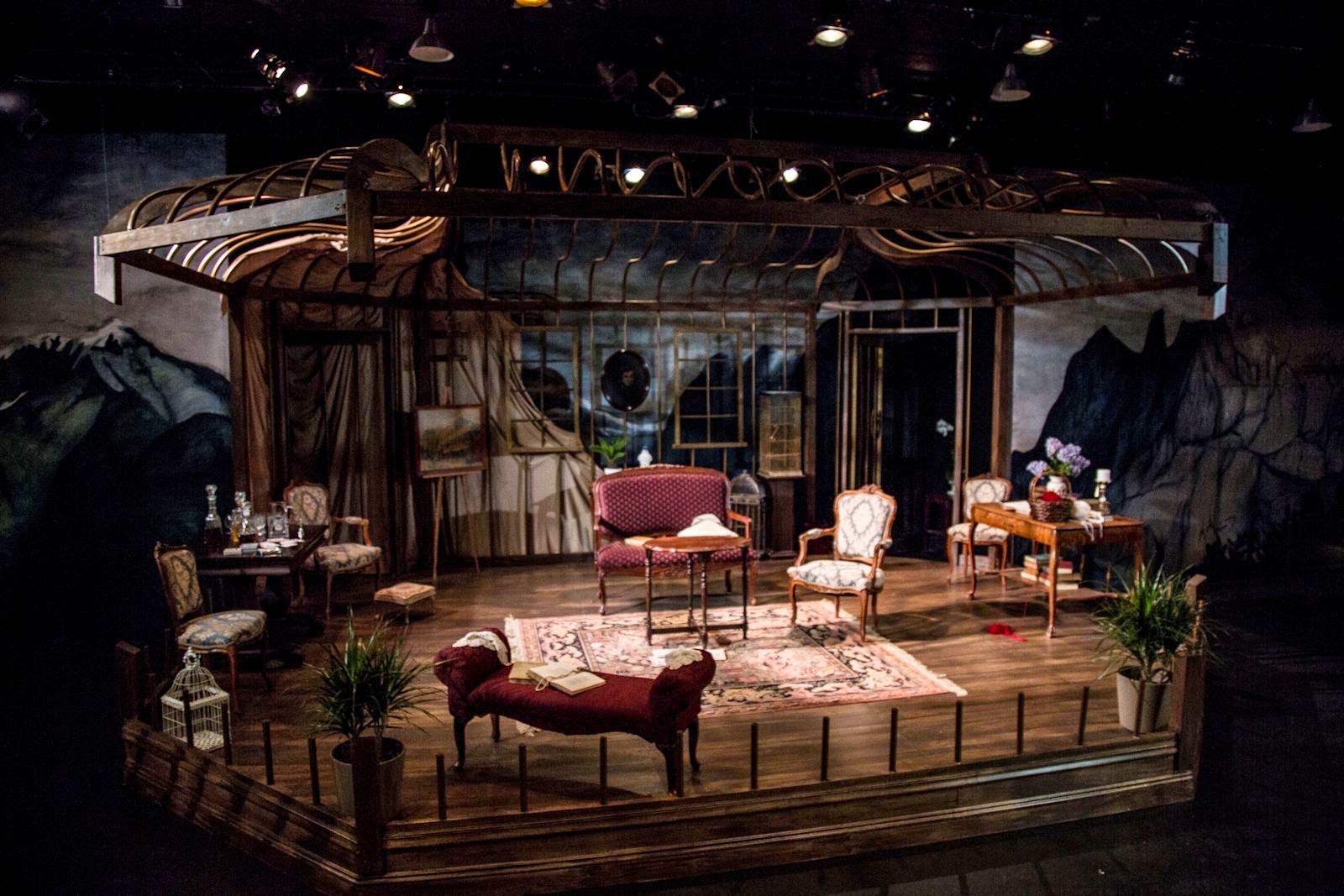ADMISSION – THE MASTERMIND BEHIND THE MUSIC
Admission, currently on stage, is fireWALL dance theater’
s powerful expression of empowerment through movement… and music. It’s natural to focus on the dance performance, awed by both the athleticism and the gracefulness of the dancers; moved by the power of the story. But what would happen if you watched the performance in a vacuum of space, where no sound can travel? Would you still ‘feel’ the performance, or would it lose something? Chances are you would still appreciate the skill of the dancers, but that much would be lost in ‘feeling’ the power of the story. Why is this? This is because the dance movements and the musical score are married into one, inseparable performance. The music not only supports the story, the music is an integral part of the story.
We took some time and talked with the mastermind behind the original musical score for Admission, Ryan McMasters. Ryan is our Resident Music Director and Sound Designer. Ryan is a true musical genius, and we’re delighted to have him as part of our team here at off the WALL. Keep reading to enjoy the interview and to learn more about what goes on behind the scenes when creating an original score.
MESMERIZING
Question: What stands out to you most about the score?
“More than any piece I’ve done for dance, the score is really inseparable from the movement and I’d like to think that Elisa would feel that the movement is equally married to the score. The nature in which it was created makes it a truly special piece for me and one that I count among my most favorite pieces to date. Central to the piece, the rope section combines just about every musical interest of mine effortlessly and the movement makes that section truly mesmerizing”
A VISION ACHIEVED THROUGH CREATIVE SOLUTIONS
Question: What was your biggest challenge?
“The first time Elisa and I were together with the ropes, it became clear that we both were in for a challenge. Rich Preffer (Set Designer) was able to translate our vague idea into a beautiful web of possibilities, but honing in our vision for how they would sound, how they would look, and how the dancers would interact with them took a lot of creative energy – there’s no textbook for how to amplify a bungee cord spider web.”
INSPIRED BY SOUNDS
Question: What can you tell us about the process of creating a musical score for a production?
“The process behind every production is totally unique, in my experience. I tend to spend the most time thinking about the specific instruments that will be a part of the score. If I’m not inspired by the sounds, it will be like pulling teeth to use them to create music. Working with dance and theater, I’ve learned to create in a way that is easily and quickly modified. If a section needs to be made longer or shorter, I want to be able to edit the music at the most basic level so that it doesn’t sound like I just chopped up a finished recording. This sort of infinite-adjustability can quickly become overwhelming, which is why I’ve found it so important to pick the sounds first and stick with them.”
INSTRUMENTATION – YOU’LL NEVER GUESS THE SOURCE
Question: Is there anything you’d like to share about your choice of instrumentation for the score?
“The sound world for this piece is really centered around the use of the ropes as a musical instrument. I amplified the actual bungee cords, and drew inspiration for the sounds from that. I knew that I wanted to use mostly analogue sounds for this show, so I limited myself to a handful of vintage synths and a drum machine. “
REPRESENTING EMOTIONALLY CHARGED SECTIONS
Question: Why did you select operatic sounding music during the uplifting moments?
“The aria that I sampled – “Ah! Non credea mirarti” from Bellini’s “La Sonnambula” – comes from an emotionally charged section of the opera where the character is wrestling with many of the same issues represented in the dance piece. I decided to use it after I had already been working on the score for Admission for a while, yet it fit in seamlessly with the existing music.”
WRITING THE SCORE: QUICK BURSTS… AND A LOT OF PREP!
Question: Tell us about the creation process. How long did it take you?
“Given the intimate relationship of music and movement in this piece, the score took the entire rehearsal period to complete. I had some of the sections roughly sketched before Elisa started with the dancers, but a majority of the work came together in very quick bursts throughout the weeks leading up to tech (and even in the first few days of tech). It wasn’t uncommon for me to send Elisa 10 minutes of the show after just a day of work in the studio. The relatively short rehearsal period forces me to work in an entirely different way than when I write concert music, where I may spend weeks working on several seconds of music.”
A COLLABORATIVE EFFORT BETWEEN TWO INDEPENDENTLY CREATIVE ARTISTS
Question: What was it like working with Elisa?
“Elisa is a very generous collaborator and really embraced creating a work that was special for both of us. Much of the music was created in the rehearsals, which allowed for immediate feedback and a very close marriage between the score and the movement. More than once, I brought a mobile studio rig to rehearsal and Elisa would sing what she had in mind, allow me to create for a few minutes, and we would have a 90% finished section of music on the spot. Any successful collaboration takes two independently creative artists whose visions are compatible; I think we have that sort of relationship.”
FIREWALL DANCE THEATER PRESENTS
ADMISSION
A WORLD PREMIERE
MAY 29-30 @ 8:00 PM; JUNE 4-6 @ 8:00 PM
MATINEE MAY 31 @ 3 PM
Choreography by Elisa-Marie Alaio
Original Music by: Ryan McMasters
our fireWALL dancers: Elisa-Marie Alaio, Glenna Clark, Grace Cohen, Sara Cohen, Cammi Nevarez, Jenna Rae Smith
 |
| fireWALL dance theater |
We took some time and talked with the mastermind behind the original musical score for Admission, Ryan McMasters. Ryan is our Resident Music Director and Sound Designer. Ryan is a true musical genius, and we’re delighted to have him as part of our team here at off the WALL. Keep reading to enjoy the interview and to learn more about what goes on behind the scenes when creating an original score.
MESMERIZING
Question: What stands out to you most about the score?
“More than any piece I’ve done for dance, the score is really inseparable from the movement and I’d like to think that Elisa would feel that the movement is equally married to the score. The nature in which it was created makes it a truly special piece for me and one that I count among my most favorite pieces to date. Central to the piece, the rope section combines just about every musical interest of mine effortlessly and the movement makes that section truly mesmerizing”
A VISION ACHIEVED THROUGH CREATIVE SOLUTIONS
Question: What was your biggest challenge?
“The first time Elisa and I were together with the ropes, it became clear that we both were in for a challenge. Rich Preffer (Set Designer) was able to translate our vague idea into a beautiful web of possibilities, but honing in our vision for how they would sound, how they would look, and how the dancers would interact with them took a lot of creative energy – there’s no textbook for how to amplify a bungee cord spider web.”
INSPIRED BY SOUNDS
Question: What can you tell us about the process of creating a musical score for a production?
“The process behind every production is totally unique, in my experience. I tend to spend the most time thinking about the specific instruments that will be a part of the score. If I’m not inspired by the sounds, it will be like pulling teeth to use them to create music. Working with dance and theater, I’ve learned to create in a way that is easily and quickly modified. If a section needs to be made longer or shorter, I want to be able to edit the music at the most basic level so that it doesn’t sound like I just chopped up a finished recording. This sort of infinite-adjustability can quickly become overwhelming, which is why I’ve found it so important to pick the sounds first and stick with them.”
INSTRUMENTATION – YOU’LL NEVER GUESS THE SOURCE
Question: Is there anything you’d like to share about your choice of instrumentation for the score?
“The sound world for this piece is really centered around the use of the ropes as a musical instrument. I amplified the actual bungee cords, and drew inspiration for the sounds from that. I knew that I wanted to use mostly analogue sounds for this show, so I limited myself to a handful of vintage synths and a drum machine. “
REPRESENTING EMOTIONALLY CHARGED SECTIONS
Question: Why did you select operatic sounding music during the uplifting moments?
“The aria that I sampled – “Ah! Non credea mirarti” from Bellini’s “La Sonnambula” – comes from an emotionally charged section of the opera where the character is wrestling with many of the same issues represented in the dance piece. I decided to use it after I had already been working on the score for Admission for a while, yet it fit in seamlessly with the existing music.”
WRITING THE SCORE: QUICK BURSTS… AND A LOT OF PREP!
Question: Tell us about the creation process. How long did it take you?
“Given the intimate relationship of music and movement in this piece, the score took the entire rehearsal period to complete. I had some of the sections roughly sketched before Elisa started with the dancers, but a majority of the work came together in very quick bursts throughout the weeks leading up to tech (and even in the first few days of tech). It wasn’t uncommon for me to send Elisa 10 minutes of the show after just a day of work in the studio. The relatively short rehearsal period forces me to work in an entirely different way than when I write concert music, where I may spend weeks working on several seconds of music.”
A COLLABORATIVE EFFORT BETWEEN TWO INDEPENDENTLY CREATIVE ARTISTS
Question: What was it like working with Elisa?
“Elisa is a very generous collaborator and really embraced creating a work that was special for both of us. Much of the music was created in the rehearsals, which allowed for immediate feedback and a very close marriage between the score and the movement. More than once, I brought a mobile studio rig to rehearsal and Elisa would sing what she had in mind, allow me to create for a few minutes, and we would have a 90% finished section of music on the spot. Any successful collaboration takes two independently creative artists whose visions are compatible; I think we have that sort of relationship.”
FIREWALL DANCE THEATER PRESENTS
ADMISSION
A WORLD PREMIERE
MAY 29-30 @ 8:00 PM; JUNE 4-6 @ 8:00 PM
MATINEE MAY 31 @ 3 PM
Choreography by Elisa-Marie Alaio
Original Music by: Ryan McMasters
our fireWALL dancers: Elisa-Marie Alaio, Glenna Clark, Grace Cohen, Sara Cohen, Cammi Nevarez, Jenna Rae Smith



Comments
Post a Comment